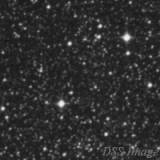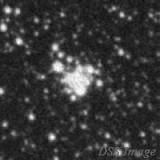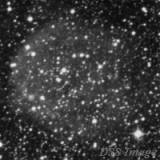Treasures Of The SMC Part IV
Back to Treasures of The SMC Index
By Andrew Murrell
Over the past few months I have featured some of the interesting objects in the SMC. Refer also: Treasures Of The SMC - Table Of Objects
This month's issue features some spectacular objects in the heart of the cloud.
KRON 28
The definitive Murrell object in this month’s article. It was discovered on photographic plates take by Harvards "ADH" Baker Schmidt telescope in South Africa in 1956.
This is a small cluster about 1.5 arc minutes in diameter with a regular round shape. There is no central condensation so the cluster appears to have an even surface brightness. No stars are resolved in or around the cluster except for a 10.5 magnitude star that lies right on the Western edge of the cluster. The difficult thing about observing this cluster is it's extremely low surface brightness, estimated to be below 15th magnitude. I would only recommend this object to observers using 16" or larger telescopes, from a very good dark sky as good sky contrast is definitely required.
The Mati Morel charts show the 10.5 magnitude star on the edge of the cluster as being a variable. I have yet been able to detect any variation in it's brightness but perhaps some of the society's variable star experts can shed some light.
NGC 299
An open cluster on the edge of the SMC. Discovered by Sir John Herschel, he described it as being "pretty bright, round nebula, very small, resolvable." The first problem of observing NGC 299 is that Uranometria and Sky Atlas 2000 list the object as a bright nebulae. It would appear that the RNGC compiled and updated in 1973 initiated this mistake, which has carried through to these Atlases. It is interesting to note that the Mati Morel charts and the Herald Bobroff Astroatlas were able to pick up this mistake and correct it in their works.
The cluster is 1 arc minute in diameter and is well defined against the background sky. No central condensation is visible but a number of the brightest stars in the outer region of the cluster become visible in the 20" telescope. The cluster appears triangular in shape with the resolved stars being positioned about the South Western corner. The triangular shape was visible at low power. The cluster is listed as being 11th magnitude and should be visible in a 6" telescope from a good dark sky. The sky background around the cluster is peppered with 15th and 16th magnitude stars making a nice backdrop.
NGC 306
NGC 306 is a small open cluster 40 arc second in diameter. It is located 6 arc minutes South West of NGC 299. The cluster is quite compact and has no central condensation. The surface brightness is even across the face of the cluster with no stars resolved. A 13.5 magnitude star can be seen about 10 arc seconds off the Southern edge of the cluster, while a pair of 12th magnitude stars frame the Eastern side 1.5 arc minutes away.
Inspecting the cluster with a UHC filter revealed no nebulosity. The cluster is positioned on the edge of the main bar of the SMC, so the sky background is not quite as distinct. The cluster is easily visible against the sky background with a well-defined edge. This cluster though similar in look to NGC 299 is fainter and should be visible in an 8" telescope.
NGC 371
At the Northern end of the central bar of the SMC lies the bright cluster NGC 371. It is located 20 arc minutes North East of NGC 346. NGC 371 is very large, covering an area in excess of 7 arc minutes. This corresponds to a real size of approximately 350 light years.
Discovered by Sir John Herschel during his observations of the SMC, he described it as a faint large cluster of 14th to 16 magnitude stars round in shape.
The cluster’s high surface brightness makes it easily visible in a 6x30 finder. A good pair of binoculars shows NGC 371 as a bright knot on the end of the main bar of the SMC, due South of the bright globular NGC 362. Hector's 90x20 finder shows the cluster complete with some of the surrounding bright stars. Using a UHC filter in this telescope reveals the faint glow of the surrounding nebulae as well. NGC 371 and NGC 346 make a marvellous pair of objects for a small rich-field telescope.
Through Hector, NGC 371 appears as a very large very diffuse cluster with the stars ranging from 9.5 magnitude to well below 16th. There is only a slight hint of condensation in the centre of the cluster. The brightest stars in the middle of the cluster are 12th to 13th magnitude and form the shape of a chair facing to the North West, with the backrest orientated North East to South West. The 13th magnitude star that makes the centre of the backrest has a chain of 13th magnitude stars trailing away to the North 3.5 arc minutes where it meets a double star. From this double star the chain of stars loops West and leads back to the centre of the cluster. Several other 12th and 13th magnitude stars are scattered about. Peppered through these brighter stars are a multitude of 14th to 16th magnitude stars. Through Hector it still appears to be resolved. This grouping of fainter stars increases the overall size of the cluster to 5 arc minutes across, still round in shape.
Throughout the cluster a ghostly glow can be glimpsed. This is the nebulosity associated with the cluster. This glow is round in shape and roughly corresponds to the shape of the cluster. Placing a UHC filter in the telescope will change the view dramatically.
The nebula is round in shape, 5 arc minutes in diameter with a slight flattening on the South Western edge. The faint members of the cluster are no longer visible but the bright chair shape is still there. The nebulae has a fairly even surface brightness with just a slight darkening toward the centre.
When I consulted the RNGC, NGC 371 was listed as an open cluster, with no mention of the nebula. Even the Mati Morel detailed charts did not show any nebulosity. Only by checking the Hodge Atlas of the SMC was I able to identify the nebulosity as Heinze 97. It seems strange that no mention of the nebula is made even though it is visible through a 10" telescope equipped with a UHC filter. In fact it may even be visible through smaller instruments.
Removing the filter and lowering the magnification revealed a faint outer halo of unresolved stars. This halo became most prominent around the South West corner of the cluster. This may be the combined glow of a small SMC star cloud or stellar association. Due to the clusters' location in the SMC the sky background is quite bright. The outer halo has no distinct edge as it blends into the general sky glow. I would estimate that the cluster would appear to increase in size to 7 arc minutes by including this halo.
The view of NGC 371 without the filter reminds me of the Helix nebula viewed through a 4" telescope at low power. This object is magnificent when viewed through any size instrument.
The brightest stars of NGC 371 approach ~7th magnitude making them some of the brightest individual stars in the SMC.




